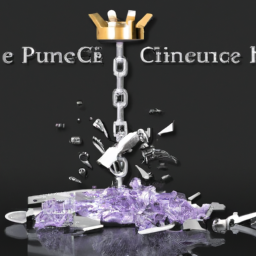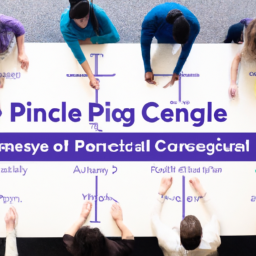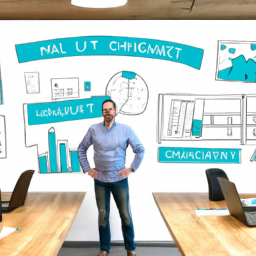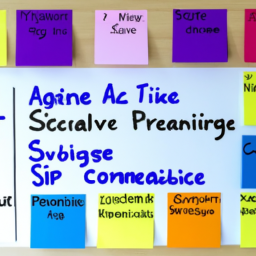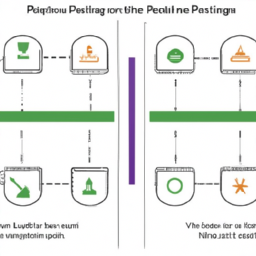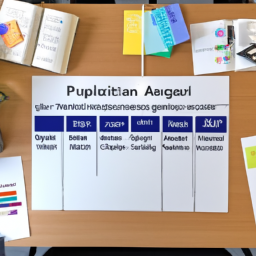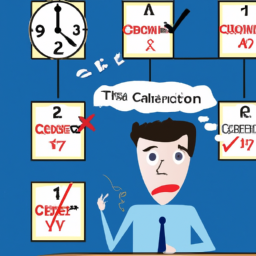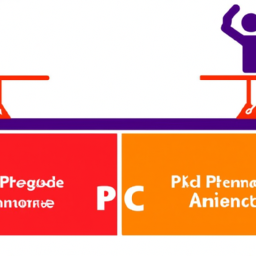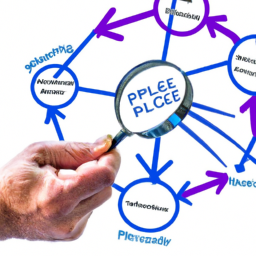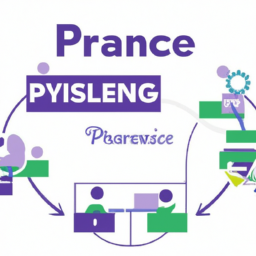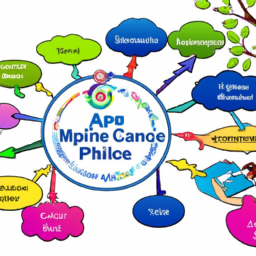Are you ready to skyrocket your PRINCE2 Agile exam score? Look no further! In this article, we will reveal 15 must-know techniques that will take your exam performance to the next level.
With a deep dive into the PRINCE2 Agile framework, mastering the processes, and applying agile principles, you’ll gain the skills necessary to excel.
Get ready to identify key roles and responsibilities, improve communication and collaboration, and ace your PRINCE2 Agile exam with confidence.
Let’s dive in!
Key Takeaways
- PRINCE2 Agile combines agile methodologies with the structured approach of PRINCE2 to effectively manage projects in a dynamic environment.
- Integrating Agile and Waterfall approaches improves collaboration, adaptability, and project management structure, leading to faster project delivery and improved communication.
- Continuous improvement, collaboration, and flexibility are key components of successful PRINCE2 Agile processes.
- Applying Agile Principles in PRINCE2 projects enhances project flexibility, adaptability, effective communication, stakeholder engagement, and self-organizing teams.
Understanding the PRINCE2 Agile Framework
Understanding the PRINCE2 Agile Framework is essential for acing the exam.
As you prepare for the PRINCE2 Agile certification, it’s important to grasp the key concepts and principles of this framework.
PRINCE2 Agile combines the flexibility of agile methodologies with the structured approach of PRINCE2, enabling organizations to effectively manage projects in a dynamic environment.
By understanding PRINCE2 Agile, you will gain insights into how to tailor the PRINCE2 principles, themes, and processes to suit agile project management.
This knowledge will not only help you excel in the exam but also equip you with practical skills that can be applied in real-world project scenarios.
The benefits of PRINCE2 Agile are numerous, including improved project control, enhanced collaboration, and increased adaptability to changing requirements.
Mastering the PRINCE2 Agile Processes
In this discussion, you will explore the key points of Agile Vs. Waterfall and Benefits of Integration.
You will learn about the fundamental differences between Agile and Waterfall methodologies and how they can impact project management.
Additionally, you will discover the advantages of integrating Agile and Waterfall approaches and the essential components that make up the PRINCE2 Agile process.
Agile Vs. Waterfall
The main difference between Agile and Waterfall is how they approach project planning and execution.
Agile project management is a flexible and iterative approach, where projects are divided into smaller increments called sprints. This allows for continuous feedback and adjustments throughout the project.
On the other hand, the Waterfall methodology follows a linear and sequential process, where each phase is completed before moving on to the next. This approach requires thorough planning and documentation upfront.
Agile emphasizes collaboration, adaptability, and frequent delivery of working software, while Waterfall focuses on upfront planning and a structured approach. Understanding these differences is crucial in choosing the right project management methodology for your organization.
Now, let’s explore the benefits of integrating Agile and Waterfall approaches to project management.
Benefits of Integration
By integrating Agile and Waterfall approaches, you’ll experience improved collaboration, adaptability, and a more structured project management process. The benefits of this integration are numerous. First, it allows for faster delivery of projects, as Agile methodologies focus on iterative development and continuous improvement. Second, it promotes better communication and collaboration between team members, as Agile emphasizes face-to-face interactions and cross-functional teams. Finally, it enables greater adaptability to changing requirements and customer needs, as both Agile and Waterfall approaches have their strengths in different project scenarios. However, there are also challenges to overcome when implementing this integration. These include managing different team dynamics, ensuring proper documentation and planning, and balancing the flexibility of Agile with the structure of Waterfall. Implementing strategies such as training and coaching, establishing clear roles and responsibilities, and utilizing hybrid project management frameworks can help overcome these challenges and ensure a successful integration.
| Benefits | Challenges | Implementation Strategies |
|---|---|---|
| Faster project delivery | Managing different team dynamics | Training and coaching |
| Improved communication and collaboration | Ensuring proper documentation and planning | Establishing clear roles and responsibilities |
| Greater adaptability to changing requirements | Balancing flexibility with structure | Utilizing hybrid project management frameworks |
Key Process Components
One important component of the integration process is understanding the key principles and frameworks. This will help you effectively analyze the key processes involved in agile project management.
To ensure a successful integration, keep in mind the following:
-
Continuous Improvement: Regularly evaluate and improve your processes to increase efficiency and effectiveness.
-
Collaboration: Foster a collaborative environment to encourage teamwork and effective communication.
-
Flexibility: Embrace change and adapt your processes to meet evolving project needs.
By understanding and applying these key principles, you will be able to navigate the complexities of the integration process and achieve successful project outcomes.
Now, let’s delve into the next section about applying agile principles in PRINCE2 projects.
Applying Agile Principles in PRINCE2 Projects
Applying Agile Principles in PRINCE2 Projects can greatly enhance project flexibility and adaptability. By incorporating agile project management techniques, you can ensure that your project remains responsive to changing requirements and customer needs.
Agile principles emphasize iterative development, collaboration, and continuous improvement. This approach allows for more frequent feedback, enabling you to make adjustments and course corrections as needed.
Agile project management also promotes effective communication and stakeholder engagement, ensuring that everyone is aligned and working towards the same goals. Additionally, it encourages self-organizing teams and empowers individuals to take ownership and responsibility for their work.
Identifying Key Roles and Responsibilities in PRINCE2 Agile
To identify key roles and responsibilities in PRINCE2 Agile, you’ll need to thoroughly analyze the project’s requirements and determine the specific tasks and duties that each team member should be responsible for. This is crucial in agile project management to ensure efficient collaboration and successful outcomes.
Here are three important roles to consider:
-
Product Owner: This individual represents the customer and is responsible for defining and prioritizing requirements, ensuring that the project meets the customer’s needs.
-
Scrum Master: The Scrum Master facilitates the agile processes, manages the team’s progress, and removes any obstacles that may hinder the project’s success.
-
Development Team: Comprising of skilled professionals, the development team is responsible for delivering the project’s outcomes and continuously improving the product.
Effective Communication and Collaboration in PRINCE2 Agile
When it comes to teamwork and productivity, clear communication strategies play a crucial role.
By fostering effective collaboration and communication within your team, you can enhance productivity and achieve your goals more efficiently.
This discussion will explore the importance of teamwork, the impact of clear communication strategies, and practical tips to improve both aspects in your PRINCE2 Agile projects.
Teamwork and Productivity
Good teamwork and high productivity are essential for success in any project. When it comes to team building, it is crucial to foster a collaborative environment where team members can trust and support each other. This can be achieved through team-building activities, regular team meetings, and open communication channels.
Additionally, effective time management plays a vital role in ensuring productivity. By setting clear goals, prioritizing tasks, and managing deadlines, teams can maximize their efficiency and meet project milestones. To enhance productivity even further, consider implementing tools and techniques such as task delegation, progress tracking, and regular performance evaluations.
By optimizing teamwork and productivity, projects can run smoothly and achieve great results.
Now that you have a strong foundation in teamwork and productivity, it’s time to explore clear communication strategies.
Clear Communication Strategies
Clear communication strategies are vital for effective collaboration and successful project outcomes. When working in a team, it’s important to employ communication techniques that promote clarity and understanding.
One key aspect of clear communication is using effective messaging. This involves delivering information in a concise and organized manner, ensuring that the intended message is conveyed accurately. By using active voice and contractions, you can make your messages more engaging and easier to comprehend.
Additionally, utilizing second person point of view can create a sense of connection and involvement with your audience.
Overall, by implementing these communication techniques, you can enhance collaboration, avoid misunderstandings, and achieve better project outcomes.
Managing Risks and Issues in PRINCE2 Agile Projects
You’ll need to effectively manage risks and issues in your PRINCE2 Agile projects. Risk management is crucial in order to identify potential threats and develop strategies to mitigate them. This involves conducting risk assessments, creating contingency plans, and regularly monitoring and reviewing risks throughout the project.
Effective issue resolution is also essential for project success. This includes promptly identifying and addressing issues as they arise, involving the appropriate stakeholders, and implementing solutions to resolve them.
Here are three key practices to help you effectively manage risks and issues in your PRINCE2 Agile projects:
-
Regularly review and update your risk register to ensure all risks are identified and managed.
-
Foster a culture of open communication and collaboration to encourage team members to report issues promptly.
-
Utilize agile techniques such as daily stand-up meetings and retrospectives to address and resolve issues in a timely manner.
Planning and Estimating in PRINCE2 Agile
Now that you have a solid understanding of managing risks and issues in PRINCE2 Agile projects, let’s move on to the next important topic: planning and estimating.
Planning is crucial for the success of any project, and in PRINCE2 Agile, there are specific techniques that can help you effectively plan your project. These planning techniques include creating a product-based plan, breaking down the project into manageable stages, and using MoSCoW prioritization to prioritize requirements.
Estimating, on the other hand, involves predicting the time, cost, and resources required for each stage of the project. In PRINCE2 Agile, there are various estimating strategies that you can use, such as expert judgment, analogous estimating, and three-point estimating. These strategies help you make accurate estimates and ensure that your project stays on track.
Agile Product Delivery in PRINCE2 Projects
Agile product delivery in PRINCE2 projects involves continuously delivering valuable products, using iterative and incremental approaches to ensure customer satisfaction. This agile project management method is becoming increasingly popular as it allows for flexibility and adaptability in the development process. Here are three key aspects of agile product delivery in PRINCE2 projects:
-
Regular reviews and feedback: Agile development methodologies emphasize the importance of frequent reviews and feedback sessions with stakeholders to ensure that the delivered products meet their needs and expectations.
-
Prioritizing customer value: Agile project management focuses on delivering products that provide the most value to the customer. This means constantly evaluating and reprioritizing requirements to ensure that the most valuable features are developed first.
-
Iterative and incremental development: Agile development methodologies encourage breaking down projects into smaller, manageable increments that can be delivered and tested quickly. This allows for regular feedback and adjustments, leading to better quality and customer satisfaction.
Monitoring and Controlling Progress in PRINCE2 Agile
In this discussion, you will explore the key points of progress tracking techniques, agile project monitoring, and controlling project deliverables.
You will learn how to effectively track the progress of your project using various techniques such as milestone tracking and burn-down charts.
Additionally, you will discover how to monitor and control your agile project using techniques like daily stand-ups and retrospectives.
Progress Tracking Techniques
Make sure you’re using effective progress tracking techniques to keep tabs on your project’s milestones and deliverables. By utilizing proper progress tracking techniques, you can ensure that your project stays on track and meets its objectives.
Here are some key techniques to consider:
-
Regular status meetings: Schedule regular meetings to discuss project progress and identify any issues or roadblocks.
-
Milestone tracking: Break your project into smaller milestones and track the completion of each milestone to gauge progress.
-
Performance evaluation methods: Use performance evaluation methods, such as key performance indicators (KPIs) or earned value management (EVM), to measure the project’s performance and identify areas for improvement.
Agile Project Monitoring
Now that you have learned about progress tracking techniques in agile project management, it’s time to delve into agile project monitoring.
Agile project monitoring is a crucial aspect of agile project governance. It involves regularly assessing the project’s progress, identifying potential risks, and making necessary adjustments to ensure successful delivery.
Agile project reporting plays a key role in this process as it enables effective communication and transparency within the project team and stakeholders. Through agile project reporting, you can provide real-time updates on project status, highlight any issues or bottlenecks, and showcase the value delivered.
Controlling Project Deliverables
To control your project deliverables, you’ll need to establish clear objectives and regularly evaluate progress towards meeting them. Here are some key strategies to help you effectively manage your project and ensure its success:
-
Clearly define project objectives: Start by clearly defining what you want to achieve with your project. This will help you stay focused and ensure that all deliverables are aligned with your goals.
-
Regularly assess progress: Set up a system to regularly measure and evaluate progress towards your project objectives. This will allow you to identify any potential risks or issues early on and take appropriate actions to address them.
-
Manage project risks: Identify and assess potential risks that could impact the success of your project. Develop a risk management plan to mitigate these risks and ensure that you have contingency plans in place.
Adapting PRINCE2 to Agile Environments
You’ll need to adapt PRINCE2 to agile environments in order to effectively manage projects in a fast-paced and ever-changing industry. Adapting agile methodologies within PRINCE2 can help you achieve greater flexibility and responsiveness in project management.
Agile project management focuses on iterative and incremental development, allowing for frequent feedback and adaptation. To adapt PRINCE2 to agile environments, you can incorporate agile practices such as Scrum or Kanban into the project management framework.
This includes setting shorter timeframes for project stages, encouraging collaboration and self-organization, and embracing change throughout the project lifecycle. By combining the best of both PRINCE2 and agile, you can optimize project delivery, improve stakeholder satisfaction, and successfully navigate the challenges of the modern business landscape.
Agile Quality Management in PRINCE2 Projects
Incorporating agile quality management into your PRINCE2 projects can enhance the overall effectiveness and efficiency of your project delivery. By adopting agile principles and practices, you can ensure that the quality of your project deliverables is continuously monitored and improved throughout the project lifecycle.
Here are three key benefits of agile quality management in PRINCE2 projects:
-
Increased flexibility: Agile approaches allow for iterative development and frequent feedback, enabling you to quickly respond to changing requirements and address any quality issues that may arise.
-
Enhanced risk management: Agile risk management techniques, such as regular risk assessments and continuous monitoring, help identify and mitigate potential risks early on, ensuring a higher level of project success.
-
Improved project planning: Agile project planning techniques, such as user stories and visual boards, facilitate better communication and collaboration among team members, resulting in more accurate and realistic project plans.
Stakeholder Engagement in PRINCE2 Agile
When it comes to stakeholder engagement in PRINCE2 Agile, effective communication is key. You need to ensure that you are effectively communicating with all stakeholders, keeping them informed and engaged throughout the project.
Additionally, managing conflicting stakeholder interests is crucial in order to maintain project alignment and avoid any potential roadblocks or delays.
Effective Stakeholder Communication
Effective stakeholder communication is essential for successful project management in the Prince2 Agile exam. Building strong relationships with stakeholders is crucial to ensure their buy-in and support throughout the project.
Here are three key strategies for effective stakeholder communication:
-
Regular and transparent communication: Keep stakeholders informed about project progress, challenges, and decisions. Use clear and concise language to avoid misunderstandings.
-
Active listening: Actively listen to stakeholders’ concerns, ideas, and feedback. Show empathy and address their needs and expectations to build trust and collaboration.
-
Tailored communication: Adapt your communication style and frequency to meet the needs of different stakeholders. Understand their preferences, priorities, and communication channels.
Managing Conflicting Stakeholder Interests
To effectively manage conflicting stakeholder interests, you need to prioritize open and honest communication. Conflict resolution is essential in stakeholder management as it helps address differences and find mutually beneficial solutions. By fostering a culture of transparency, you can encourage stakeholders to voice their concerns and actively participate in the decision-making process.
Here is a table illustrating some strategies for managing conflicting stakeholder interests:
| Strategies for Managing Conflicting Stakeholder Interests | Benefits |
|---|---|
| Active listening and empathy | Promotes understanding and builds trust |
| Facilitating open dialogue | Encourages collaboration and shared decision-making |
| Identifying common goals and interests | Allows for finding win-win solutions |
| Negotiation and compromise | Helps reach mutually satisfactory agreements |
| Mediation or third-party intervention | Provides impartial guidance and resolution |
Implementing these strategies can help navigate conflicts and ensure that stakeholder interests are addressed effectively. By actively managing and resolving conflicts, you can foster positive relationships with stakeholders and achieve project success.
Agile Change Control in PRINCE2 Projects
You’ll need to understand how Agile Change Control works in PRINCE2 projects. Agile change management is an essential aspect of implementing agile practices in PRINCE2 projects. Here are three key points to consider:
-
Flexibility: Agile Change Control allows for quick and efficient response to changing requirements and priorities throughout the project.
-
Continuous Improvement: It promotes a culture of continuous improvement by encouraging regular feedback and adapting the project approach accordingly.
-
Collaboration: Agile Change Control emphasizes collaboration and open communication among project stakeholders to ensure everyone is aligned with the changes being made.
Continuous Improvement in PRINCE2 Agile
Incorporating continuous improvement practices in PRINCE2 Agile projects allows you to adapt and enhance your project approach based on regular feedback. By constantly evaluating and refining your processes, you can ensure that your project stays on track and delivers the desired outcomes. There are several continuous improvement techniques that can be applied in PRINCE2 Agile projects, such as retrospectives, where the team reflects on what went well and what could be improved. Another technique is the use of key performance indicators (KPIs) to measure agile success. These metrics provide valuable insights into the project’s progress and help identify areas for improvement. By implementing these continuous improvement techniques, you can optimize your project’s performance and increase the chances of achieving success.
| Continuous Improvement Techniques | Measuring Agile Success |
|---|---|
| Retrospectives | Key Performance Indicators |
| Process Evaluation | Agile Success Metrics |
| Feedback Gathering | Performance Analysis |
| Stakeholder Engagement | Continuous Improvement |
| Adaptation and Refinement | Quality Assurance |
Exam Preparation and Test-Taking Strategies
When preparing for the exam, it’s important to familiarize yourself with effective test-taking strategies. Here are some exam strategies that will help you ace your test preparation:
-
Time management: Allocate your time wisely to ensure that you can answer all the questions within the given timeframe.
-
Read and understand the instructions: Take the time to carefully read and understand the instructions before starting the exam to avoid any unnecessary mistakes.
-
Practice, practice, practice: Practice with sample questions and past exams to get familiar with the format and types of questions that may be asked.
By incorporating these exam strategies into your test preparation, you will be well-equipped to tackle the exam confidently and achieve a high score.
Remember to stay calm and focused during the exam, and trust in the preparation you have done. Good luck!
Frequently Asked Questions
What Are Some Key Roles and Responsibilities in PRINCE2 Agile?
In PRINCE2 Agile, there are key roles and responsibilities that you must know.
These roles include the project manager, who is responsible for overall project success, and the product owner, who ensures the product meets customer needs.
Other roles include the business analyst, who analyzes requirements, and the team manager, who coordinates the work of the team.
Understanding these roles and their responsibilities is crucial for success in the PRINCE2 Agile exam.
How Can Effective Communication and Collaboration Be Achieved in PRINCE2 Agile?
To achieve effective communication and collaboration in PRINCE2 Agile, you need to establish clear channels of communication and encourage open dialogue. Use techniques like regular team meetings, daily stand-ups, and virtual collaboration tools to facilitate effective communication.
Foster a collaborative environment by promoting active listening, encouraging diverse perspectives, and fostering a culture of trust and respect. By prioritizing effective communication and implementing collaboration techniques, you can enhance project success in PRINCE2 Agile.
What Are Some Techniques for Managing Risks and Issues in PRINCE2 Agile Projects?
To manage risks and issues in PRINCE2 Agile projects, you need effective techniques.
Risk management involves identifying, assessing, and mitigating potential risks. Techniques like risk registers, risk assessments, and risk response strategies can help you stay proactive.
Issue management focuses on resolving problems that arise during the project. Techniques like issue logs, escalation procedures, and regular reviews can ensure timely resolution.
How Does PRINCE2 Agile Adapt to Agile Environments?
When it comes to adapting to agile environments, PRINCE2 Agile takes an adaptive approach that aligns with the principles of Agile methodology. It emphasizes flexibility, collaboration, and continuous improvement.
By incorporating Agile practices such as Scrum and Kanban, PRINCE2 Agile allows for iterative development, frequent feedback, and quick adaptation to changing requirements.
This approach ensures that projects are delivered in a timely manner, with a focus on high-quality outcomes that meet customer needs.
What Are Some Strategies for Exam Preparation and Test-Taking in the PRINCE2 Agile Exam?
When preparing for the PRINCE2 Agile exam, it’s important to have effective exam study tips and test-taking strategies.
To succeed, start by familiarizing yourself with the exam format and content. Create a study schedule to cover all the topics and practice with sample questions.
During the exam, manage your time wisely and read each question carefully. Don’t forget to review your answers before submitting.
These strategies will help you achieve a high score.
Conclusion
Congratulations! You’ve now mastered the 15 must-know techniques for the PRINCE2 Agile exam. With a deep understanding of the framework, processes, and principles, you’re equipped to excel in managing PRINCE2 projects with agility.
By effectively communicating and collaborating, engaging stakeholders, and implementing agile change control, you’ll ensure project success. Remember to continuously improve and adapt, always striving for perfection.
As you approach the exam, use your well-prepared strategies to confidently navigate through the questions and achieve a skyrocketing score. Good luck on your journey to becoming a PRINCE2 Agile expert!

